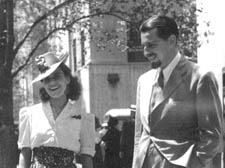|
|
 |
| |

Norman Lewis with his wife Ernestina in Fifth Avenue, New York, 1939. |
Bohemian rhapsody: a birds eye view of ‘Italian’ Bloomsbury
Norman Lewis is one of the greatest travel writers in the English language,
but his unique outlook was forged in the local traditions of Little Italy, writes Dan Carrier
Semi-Invisible Man: the Life of Norman Lewis.
By Julian Evans. Jonathan Cape £25.
FROM a perch in the front room, the owl would glower silently at any one who entered, descending from is eyrie only to devour day-old chicks.
For Norman Lewis, the travel writer, the bird typified the exotic world he was entering into by marrying Ernestina Corvajo, a young Sicilian whose family had decamped from the island, via America, to the four-storey home in Gordon Street, Bloomsbury.
Lewis, who at the time was running a photographic shop based in Holborn, was set to become one the greatest travel writers the English language has ever produced. But in the early-1930s he was still looking for his voice, and, according to his biographer Julian Evans, the eccentric household run by his mother-in-law was one of the key experiences in his development as a writer.
Lewis, who came from Enfield, met and married Ernestina in 1931.
They were offered lodgings at Gordon Street – and he was
surprised to find he shared his home not only with a beady-eyed owl in the front room, but a host of animals and people from around the world: it was an open house in typically Sicilian style, where rooms were handed over to anyone who needed a place to rest. Some lodgers stayed, unofficially, for years.
Evans’s biography touches on his time in Bloomsbury, but Norman’s own memoir, The World, The World, covers in depth his experience in an archetypal Anglo-Italian household between the wars.
It was a time when Little Italy stretched from Soho through Bloomsbury to Holborn, and his snapshot of life in the Corvajo household was typical of other Italian people living in Camden at the time, where extended families gathered to live under one roof.
Lewis recalled: “It was a calm Bloomsbury precinct a good mile from the periphery of Soho and half that distance from the small settlements of foreigners, largely Italian or Greek, scattered like iron filings round the magnet of Tottenham Court Road. It was largely peopled by those having connections with London university – academics who may have observed with surprise the process by which over a few years a variety of foreigners had crammed themselves into Number Four to produce a singular community.”
Norman wrote that his father-in-law, Ernesto Corvajo, and his wife Maria had arrived in Bloomsbury via the United States – they’d left the US under some kind of cloud relating to unproven, and unspoken, criminal activity. Originally from Sicily, they were from the neighbourhood of Palermo in which “people who work in the country return to the town after sunset, and town houses – at least in Ernesto’s day – had become little fortresses stuffed with near and distant relations and friends”. This became the model for the home in Gordon Street.
“The Corvajos were extremely gregarious,” writes Norman. “They were also fond of animals. They possessed an aggressive and smelly mongrel dog, a large somnolent cat reduced by a diet of pickled mushrooms and tagliatelle con vongoli to a state of chronic incontinence, and a little owl [Athene noctua vidali] imported from Brescia and chained to a perch in the dining room from which it surveyed the scene with imperturbable golden eyes.
“A kestrel, also imported from Italy, was kept in a separate room, perching usually on the head of a fairish copy of Donatello’s David.
“Both these birds were sensibly fed on day-old chicks supplied by a pet shop, which they devoured in a lackadaisical fashion, with little evidence of appetite.”
Things got even wilder downstairs, remembers Lewis.
“The basement was the territory of Maria’s cockerels reared by her since infancy without access to daylight, on legs sometimes almost doubled over by rickets,” he writes. “Despite this disablement they launched fierce, staggering attacks on all who approached them.”
Lewis recalled after the war how “...those were the days of the last fading flush of autumnal light over literary Bloomsbury, the bohemianism of the Fitzroy Tavern, the lectures on sexual emancipation at the Conway Hall, Bertrand Russell and Dr Joads’ pleasurable re-shapings of London bourgeois life.”
Lewis became known for his 33 travel books as well as hundreds of articles: perhaps his best-known works are Naples ’44, which describes in detail the effect of the Allied invasion and the stubborn rearguard action fought by the Nazis on the inhabitants of the Italian port, and Voices of the Old Sea, a travel book written in the aftermath of the war about two Spanish fishing villages.
In all of these works, the importance of his time in the crazy household of the Corvajos cannot be underestimated. But they also offer a snapshot of an area of north London which has disappeared.
|
 |
|
 |
| |
|
 |
|


